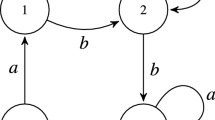Abstract
A synchronizing word brings all states of a finite automaton to the one particular state. From practical reasons the synchronizing words should be as short as possible. Unfortunately, the decision version of the problem is NP-complete. In this paper we present a new evolutionary approach for finding possibly short synchronizing words for a given automaton. As the optimization problem has two contradicting goals (the word’s length and the word’s rank) we use a 2 population feasible-infeasible approach. It is based on the knowledge on words’ ranks of all prefixes of a given word. This knowledge makes the genetic operators more efficient than in case of the standard letter-based operators.
J. Kowalski—Supported in part by the National Science Centre, Poland under project number 2014/13/N/ST6/01817.
A. Roman—Supported in part by the National Science Centre, Poland under project number 2015/17/B/ST6/01893.
Similar content being viewed by others
References
Černý, J.: Poznámka k homogénnym eksperimentom s konečnými automatami. Matematicko-fyzikálny Časopis Slovenskej Akadémie Vied 14(3), 208–216 (1964). In Slovak
Pomeranz, I., Reddy, S.: On achieving complete testability of synchronous sequential circuits with synchronizing sequences. In: IEEE Proceedings of International Test Conference, pp. 1007–1016 (1994)
Sandberg, S.: 1 Homing and synchronizing sequences. In: Broy, M., Jonsson, B., Katoen, J.-P., Leucker, M., Pretschner, A. (eds.) Model-Based Testing of Reactive Systems. LNCS, vol. 3472, pp. 5–33. Springer, Heidelberg (2005). doi:10.1007/11498490_2
Benenson, Y., Adar, R., Paz-Elizur, T., Livneh, Z., Shapiro, E.: DNA molecule provides a computing machine with both data and fuel. Proc. Natl. Acad. Sci. 100(5), 2191–2196 (2003)
Eppstein, D.: Reset sequences for monotonic automata. SIAM J. Comput. 19, 500–510 (1990)
Goldberg, K.Y.: Orienting polygonal parts without sensors. Algorithmica 10(2–4), 201–225 (1993)
Berlinkov, M.V.: Approximating the minimum length of synchronizing words is hard. Theory Comput. Syst. 54(2), 211–223 (2014)
Kowalski, J., Szykuła, M.: A new heuristic synchronizing algorithm (2013). http://arxiv.org/abs/1308.1978
Roman, A.: Synchronizing finite automata with short reset words. In: Applied Mathematics and Computation. ICCMSE-2005, vol. 209, pp. 125–136 (2009)
Roman, A., Szykuła, M.: Forward and backward synchronizing algorithms. Expert Syst. Appl. 42(24), 9512–9527 (2015)
Kisielewicz, A., Kowalski, J., Szykuła, M.: A fast algorithm finding the shortest reset words. In: Du, D.-Z., Zhang, G. (eds.) COCOON 2013. LNCS, vol. 7936, pp. 182–196. Springer, Heidelberg (2013). doi:10.1007/978-3-642-38768-5_18
Kisielewicz, A., Kowalski, J., Szykuła, M.: Computing the shortest reset words of synchronizing automata. J. Comb. Optim. 29(1), 88–124 (2015)
Trahtman, A.N.: An efficient algorithm finds noticeable trends and examples concerning the Černy conjecture. In: Královič, R., Urzyczyn, P. (eds.) MFCS 2006. LNCS, vol. 4162, pp. 789–800. Springer, Heidelberg (2006). doi:10.1007/11821069_68
Roman, A.: Genetic algorithm for synchronization. In: Dediu, A.H., Ionescu, A.M., Martín-Vide, C. (eds.) LATA 2009. LNCS, vol. 5457, pp. 684–695. Springer, Heidelberg (2009). doi:10.1007/978-3-642-00982-2_58
Kimbrough, S.O., Koehler, G.J., Lu, M., Wood, D.H.: On a feasible-infeasible two-population (FI-2Pop) genetic algorithm for constrained optimization: distance tracing and no free lunch. Eur. J. Oper. Res. 190(2), 310–327 (2008)
Togelius, J., Yannakakis, G.N., Stanley, K.O., Browne, C.: Search-based procedural content generation: a taxonomy and survey. IEEE Trans. Comput. Intell. AI Games 3(3), 172–186 (2011)
Liapis, A., Yannakakis, G.N., Togelius, J.: Sentient sketchbook: computer-aided game level authoring. In: Conference on the Foundations of Digital Games, pp. 213–220 (2013)
Liapis, A., Holmgård, C., Yannakakis, G.N., Togelius, J.: Procedural personas as critics for dungeon generation. In: Mora, A.M., Squillero, G. (eds.) EvoApplications 2015. LNCS, vol. 9028, pp. 331–343. Springer, Cham (2015). doi:10.1007/978-3-319-16549-3_27
Scirea, M., Togelius, J., Eklund, P., Risi, S.: MetaCompose: a compositional evolutionary music composer. In: Johnson, C., Ciesielski, V., Correia, J., Machado, P. (eds.) EvoMUSART 2016. LNCS, vol. 9596, pp. 202–217. Springer, Cham (2016). doi:10.1007/978-3-319-31008-4_14
Ananichev, D.S., Volkov, M.V., Zaks, Y.I.: Synchronizing automata with a letter of deficiency 2. In: Ibarra, O.H., Dang, Z. (eds.) DLT 2006. LNCS, vol. 4036, pp. 433–442. Springer, Heidelberg (2006). doi:10.1007/11779148_39
Ananichev, D., Gusev, V., Volkov, M.: Slowly synchronizing automata and digraphs. In: Hliněný, P., Kučera, A. (eds.) MFCS 2010. LNCS, vol. 6281, pp. 55–65. Springer, Heidelberg (2010). doi:10.1007/978-3-642-15155-2_7
Ananichev, D.S., Volkov, M.V., Gusev, V.V.: Primitive digraphs with large exponents and slowly synchronizing automata. J, Math. Sci. 192(3), 263–278 (2013)
Wielandt, H.: Unzerlegbare, nicht negative Matrizen. Math. Z. 52, 642–648 (1950)
Author information
Authors and Affiliations
Corresponding author
Editor information
Editors and Affiliations
Rights and permissions
Copyright information
© 2017 Springer International Publishing AG
About this paper
Cite this paper
Kowalski, J., Roman, A. (2017). A New Evolutionary Algorithm for Synchronization. In: Squillero, G., Sim, K. (eds) Applications of Evolutionary Computation. EvoApplications 2017. Lecture Notes in Computer Science(), vol 10199. Springer, Cham. https://doi.org/10.1007/978-3-319-55849-3_40
Download citation
DOI: https://doi.org/10.1007/978-3-319-55849-3_40
Published:
Publisher Name: Springer, Cham
Print ISBN: 978-3-319-55848-6
Online ISBN: 978-3-319-55849-3
eBook Packages: Computer ScienceComputer Science (R0)




